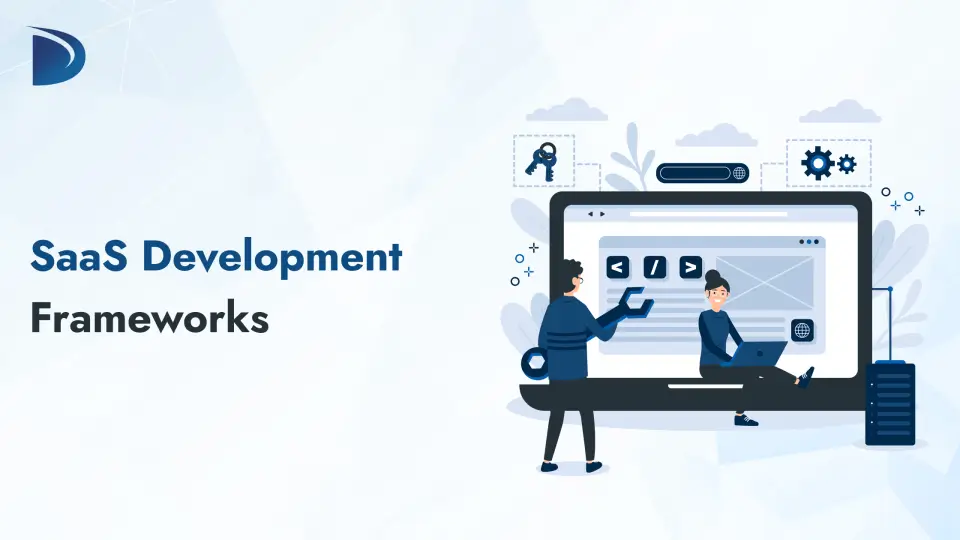Table of Contents
Selecting the proper SaaS development framework is a crucial decision that significantly impacts your application’s development, performance, and scalability. The framework you choose impacts how quickly you can build your product, how well it performs under load, and how easily it integrates with modern cloud services. With numerous options available, picking the best framework depends on your team’s expertise, project requirements, and long-term goals. This guide offers an in-depth examination of what makes a great SaaS framework, compares top options, and helps you select the right one for your project.
What is a SaaS Development Framework?
A SaaS development framework is a collection of tools, libraries, and design patterns that streamline the creation and management of Software as a Service (SaaS) applications. These frameworks handle essential tasks, such as user authentication, billing, data management, and API integrations, allowing developers to focus on building unique features. By providing pre-built components, a good framework reduces development time, enhances security, and ensures your app can scale with growing demand. It also facilitates seamless integration with cloud platforms, databases, and third-party services, which are critical for modern SaaS products.
Why Choosing the Right Framework Matters
The framework you select sets the foundation for your SaaS application. A poor choice can lead to slow development, performance bottlenecks, or scalability issues, while the proper framework accelerates time-to-market, improves user experience, and supports long-term growth. Key factors to consider include:
- Ease of Use: Frameworks with clear documentation and simple syntax reduce the learning curve.
- Scalability: The framework should be able to handle increased traffic and data as your user base grows.
- Performance: Fast frameworks improve user satisfaction and reduce infrastructure costs.
- Community and Support: Active communities provide tutorials, plugins, and updates.
- Integration: Ensure compatibility with APIs, cloud services, and databases.
Top SaaS Development Frameworks for 2025
Below, we explore eight leading SaaS development frameworks, comparing their strengths, weaknesses, and ideal use cases. In-depth descriptions of each framework follow a detailed comparison table.
| Framework | Language | Best For | Pros | Cons |
|---|---|---|---|---|
| Symfony | PHP | Enterprise-grade SaaS apps | Modular components, strong security, supports complex logic, scalable | Steeper learning curve, complex setup, overkill for small apps |
| ReactJS | JavaScript | Lightweight, modular frontends | Fast rendering, reusable components, vast ecosystem, frequent updates | Needs backend tools, complex state management, potential code inconsistency |
| Docker | Container Tool | Deployment and microservices | Needs backend tools, complex state management, and potential code inconsistency | Requires DevOps expertise, complex container management |
| Angular | TypeScript | Lightweight, frontend frontends | Comprehensive tools, TypeScript support, Google-backed, great CLI | Verbose, large bundle sizes, less flexible than React |
| Django | Python | Rapid MVP development | Built-in admin panel, strong security, scalable, excellent documentation | Restrictive for custom architectures, less flexible for complex designs |
| Laravel | PHP | MVPs and mid-sized apps | Elegant syntax, built-in tools, fast setup, great for MVPs | Needs optimization for heavy loads, less customizable than Symfony |
| Vue.js | JavaScript | Interactive frontend interfaces | Easy to learn, reactive data binding, flexible for SPAs, good docs | Smaller enterprise adoption, limited tooling compared to Angular |
| Go (Golang) | Go | High-performance backends | Fast execution–great concurrency, simple syntax, single-binary deployment | Limited high-level features, smaller community, not suited for UI |
1. Symfony
Symfony is a robust PHP framework designed for scalable, enterprise-level SaaS applications. Its modular architecture and reusable components make it ideal for complex projects requiring robust business logic. Symfony’s strict coding standards ensure maintainable code, while its support for RESTful APIs and Doctrine ORM simplifies database interactions. Frequently highlighted in SaaS development guides, Symfony is a top choice for projects prioritizing stability and flexibility.
- Pros: Highly modular, strong security features, scalable, built-in testing tools, supports RESTful APIs.
- Cons: Steeper learning curve, complex initial setup, may require third-party integrations for some features.
- Best For: Large-scale SaaS applications with complex requirements and long-term maintenance needs.
Symfony’s flexibility makes it suitable for enterprise-grade apps, but its complexity can be overwhelming for smaller projects or teams with limited PHP experience. It shines in scenarios where custom workflows and high stability are critical.
2. ReactJS
ReactJS, a JavaScript library by Meta, is widely used for building fast, interactive user interfaces. Its virtual DOM ensures quick rendering, and its component-based architecture promotes code reusability. React is ideal for SaaS platforms requiring frontend responsiveness and dynamic interfaces. However, if you’re relying solely on the frontend, you’ll need additional tools like Node.js or Express for backend functionality.
- Pros: Fast UI updates, reusable components, vast ecosystem, strong community, frequent updates.
- Cons: Requires backend tools, complex state management (e.g., Redux), and high flexibility, which can lead to inconsistent code.
- Best for: SaaS apps that require dynamic, user-friendly interfaces with fast rendering.
React’s extensive ecosystem and community support make it a choice for modern SaaS frontends, but teams must enforce coding standards to avoid messy codebases.
3. Docker
Docker is a containerization platform that packages SaaS applications and their dependencies into portable environments. It ensures consistency across development, staging, and production, making it essential for modern CI/CD pipelines. Docker simplifies deployment and scaling, particularly for cloud-native SaaS applications that utilize microservices.
- Pros: Streamlines deployment, supports CI/CD, lightweight compared to VMs, facilitates microservices.
- Cons: Requires DevOps expertise, complex container management, and potential security risks if misconfigured.
- Best For: SaaS apps with complex deployment needs or microservices architecture.
Docker is a must-have for teams adopting DevOps practices, but it requires knowledge of container orchestration tools, such as Kubernetes, for large-scale deployments.
4. Angular
Angular, a TypeScript-based framework developed by Google, provides a comprehensive frontend solution for building complex SaaS applications. Its built-in tools for routing, HTTP requests, and form handling streamline development, while two-way data binding simplifies dynamic interfaces. Angular’s structure makes it ideal for enterprise front-end projects.
- Pros: Comprehensive frontend tools, TypeScript support, excellent CLI, Google-backed, uniform project structure.
- Cons: Steeper learning curve, large bundle sizes, less flexible than React, not ideal for lightweight MVPs.
- Best for: Enterprise SaaS apps that require a robust structure and long-term support.
Angular’s all-in-one approach suits teams building large, maintainable SaaS applications, but its complexity can slow down smaller projects.
5. Laravel
Laravel is a modern PHP framework known for its elegant syntax and developer-friendly features. With built-in tools for authentication, queues, and templating (Blade), it accelerates MVP development. Laravel’s ecosystem, including tools like Nova and Horizon, enhances productivity.
- Pros: Easy-to-read syntax, built-in tools, fast setup, active community, great for MVPs.
- Cons: May need optimization for high loads, less customizable than Symfony, relies on Laravel conventions.
- Best for: Small to mid-sized SaaS apps or rapid MVP development.
Laravel’s simplicity and speed make it a favorite for startups, but enterprise projects may require additional optimization.
6. Vue.js
Vue.js is a lightweight, progressive JavaScript framework ideal for building modular frontends. Its gentle learning curve and reactive data binding make it accessible for teams new to modern JavaScript frameworks. Vue works well for single-page applications (SPAs) and integrates easily with existing projects.
- Pros: Easy to learn, reactive data binding, flexible for SPAs, clear documentation, and active development.
- Cons: Smaller enterprise adoption, a limited ecosystem compared to React, and requires a strict coding discipline.
- Best for: Front-end teams or Those Needing Fast, Simple Frontend Development.
Vue’s simplicity and flexibility make it an excellent choice for smaller SaaS teams, although it may lack the enterprise support that Angular or React offer.
7. Go (Golang)
Go, developed by Google, is a high-performance, statically typed language designed for speed and concurrency. Its goroutines and single-binary compilation make it ideal for building efficient SaaS backends, especially for real-time processing.
- Pros: Fast execution, excellent concurrency, simple syntax, single-binary deployment, built-in error handling.
- Cons: Limited high-level features, smaller community, not suited for UI-heavy apps.
- Best For: High-performance SaaS backends with real-time or high-load requirements.
Go’s performance and simplicity make it a strong choice for backend-heavy SaaS applications, but it requires additional frameworks for web development.
8. Django
Django is a Python-based framework that emphasizes rapid development and clean design. Its “batteries-included” philosophy provides tools like an admin panel, ORM, and authentication, making it perfect for SaaS MVPs. Django’s security features and scalability make it a reliable choice.
- Pros: Fast MVP development, strong security, scalability with WSGI/ASGI, excellent documentation, and a robust Python ecosystem.
- Cons: Restrictive for custom architectures, less flexible for complex designs.
- Best For: Rapid development of secure SaaS MVPs.
Django’s all-in-one approach and Python’s readability make it an ideal choice for startups and teams that prioritize speed and security.
How to Choose the Right SaaS Framework
- Define Project Goals: Decide whether you prioritize speed to market, scalability, or ease of maintenance.
- Assess Team Expertise: Choose a framework that your team is familiar with or can learn quickly (e.g., PHP for Laravel, Python for Django).
- Evaluate Scalability Needs: Ensure the framework supports growth, especially for enterprise apps (e.g., Symfony, Go).
- Check Ecosystem and Integrations: Look for frameworks with strong community support and compatibility with APIs, databases, and cloud services.
- Test Performance: Run prototypes to evaluate speed and resource usage, especially for high-traffic apps.
- Consider Long-Term Maintenance: Frameworks like Symfony and Angular promote the development of maintainable codebases for long-term projects.
Conclusion
Choosing the proper SaaS development framework is about aligning your project’s needs with your team’s skills and long-term vision. Laravel and Django are excellent for rapid MVP development, while Symfony and Angular are suited for complex, enterprise-grade applications, and Vue.js excels in building dynamic frontends. Go offers unmatched backend performance, and Docker simplifies deployment. By evaluating your priorities, speed, scalability, or maintainability, you can select a framework that sets your SaaS development up for success.
FAQs
How do I choose between a backend and frontend framework for SaaS development?
It depends on the complexity of your product and the skills of your development team. For data-intensive applications, a robust backend like Django or Laravel is crucial. If user interface and frontend responsiveness are priorities, focus on frontend tools like React or Angular. In most cases, you’ll need a combination of both.
What kind of hosting is best for SaaS apps?
Cloud hosting platforms like AWS, Azure, and Google Cloud are most popular due to their scalability and global reach. If you’re using the Azure SaaS Kit, it’s best to host within Azure’s ecosystem for tighter integration and smoother deployment.
How do SaaS development frameworks impact time-to-market?
Frameworks with built-in features can reduce development time significantly. They help avoid reinventing the wheel, allowing your team to focus on the core features that set your product apart.

